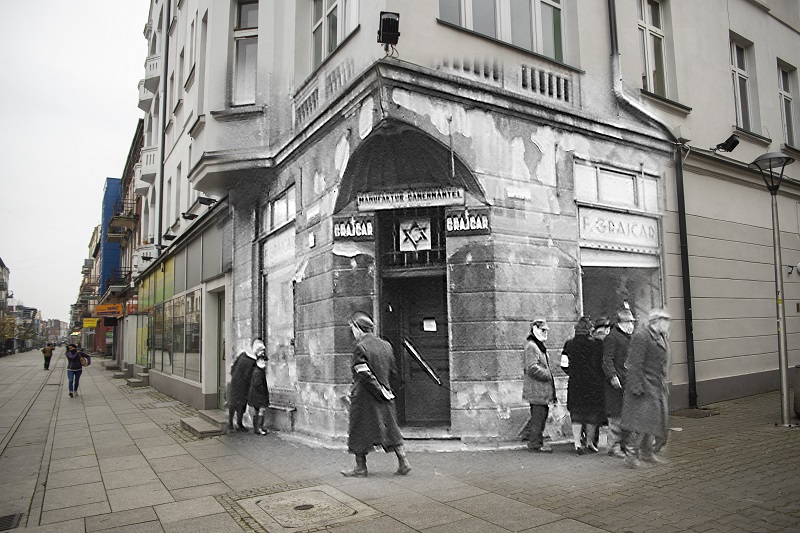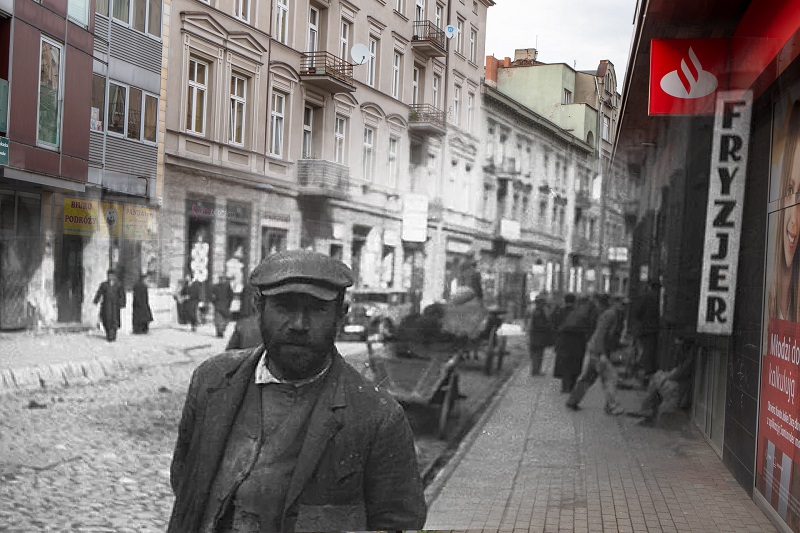| Tomasz Grząślewicz |
I’ve walked up and down this street for ages, but usually just on the way from one place to another. It was rarely a destination for us, because all the spots interesting for high school students, such as teenager-friendly pubs and music stores selling cassettes, were somewhere else. It was always full of traffic and disorder, in line with its name. Its gates and courtyards did not have a good reputation, so we would never take a closer look at them. Not until we began to discover the history of Targowa, one of the oldest streets in the city, while working on A Guidebook to Jewish Heritage in Sosnowiec, which was published in July 2021.
Administrator
First there were swamps and wasteland overgrown with grass, a no man’s land some 700 feet from the Warsaw-Vienna Railway Station built in 1859 as the foundation of the future city. In the area that would eventually become Targowa Street, a Jew named Abram Izaak Blumental, who came from the nearby town of Modrzejów, bought a plot of land and erected a house. The pioneer must have enjoyed the trust of the people living in the settlement: in 1880 he was elected the first administrator of the newly established village of Sosnowiec. Until then, the neighborhood which is now the city center, was part of Pogoń – a medieval village and a current district of Sosnowiec. Blumental was the administrator of the village for 10 years. Before the so-called Great Synagogue was built on Dekerta Street, his house had also been home to a Jewish hall of prayer.
Tzadik
Religion was strongly present on Targowa during the interwar period, when the four-story apartment building owned by Samuel Henoch Rabinowicz, the last tzadik of the Hasidic dynasty of Radomsk, was erected at the intersection with Modrzejowska. Tzadik Rabinowicz was greatly respected by Hasidim who traveled from all over Poland to get his advice. Contrary to the usual practice, he did not accept any donations from them, except for those specifically intended for the network of 36 yeshivas (religious schools) which he had founded. The most important of these schools was located in Rabinowicz’s apartment building on 12 Targowa Street.
The history of Radomsk dynasty was tragic. Tzadik’s only daughter gave birth to a boy after many years of trying. The boy’s circumcision was a major event attended by hundreds of Hasidim. Unfortunately, the child died in infancy. Tzadik Rabinowicz and other members of his family were murdered in the Warsaw ghetto in August 1942.
Pianist
We should also mention another Jewish family with roots in Sosnowiec that lived in the closed district of Warsaw during WWII. One of its members, Władysław Szpilman, a musician and composer of worldwide fame thanks to Roman Polański’s movie The Pianist, grew up just several hundred feet from tzadik Rabinowicz’s apartment building, in the house on 18 Targowa Street. This is where his adventure with music began: his mother gave him the first piano lessons, whereas his father was a violinist and a famous bandleader (as the posters called him) performing in Sosnowiec restaurants. Nowadays, Władysław Szpilman’s image looks at us from the third floor of the apartment building, and the plaque on the building wall reminds us of the place where he was born.
Zionists
No commemoration can be found at house no. 9, on the other side of Targowa from Tzadik Rabinowicz’s house, towards Małachowskiego Street. However, equipped with proper knowledge, we can imagine how this two-story apartment building boils with ideas and concepts: for many years it was the headquarters of several Zionist organizations aiming to create a Jewish state in the historic land of Israel. This place was regularly visited by a young teacher and novice poet Chaim Nachman Bialik, regarded as the national bard of Israel.
Collage: former inhabitants of the city are walking through the intersection of Targowa and Modrzejowska on the right, whereas contemporary residents of Sosnowiec are coming towards them on the left. Archival photo from the collection of Dariusz Kmiotek, collage author: Radek Struzik
Courtyard
A couple of years after leaving Sosnowiec, Bialik wrote The City of Slaughter, the poem about his experience of visiting Kishinev in the Russian Empire after the pogrom of Jews in 1903. The City of Slaughter is shockingly brutal. From our perspective, it also stands out as a warning against what might happen. And, unfortunately, it did happen.
In 1939-1943, Targowa Street was the center of Jewish life not only for Sosnowiec, but also for the entire region. Tzadik Rabinowicz’s building became the seat of the Central Office of the Jewish Council of Elders in East Upper Silesia – the organization led by controversial Moniek (Moshe) Merin, which had thousands of Jews under its jurisdiction. Other important addresses on Targowa Street during WWII included the Jewish post office (no. 4), one of seven Jewish bakeries (no. 6), the Jewish infirmary (no. 7) and the headquarters of Jewish police (no. 15).
In August 1942, following the so-called ‘selection’ on Sosnowiec stadiums, thousands of people were brought by Gestapo to Targowa before deportation to Auschwitz. On those hot summer days, the houses and courtyards on 4 and 8 Targowa Street saw desperate attempts to save lives, farewells, escapes through attics and basements, suicides, miraculous rescues and last moments before transport to the death camp.
I used to work in the apartment building on 4 Targowa Street. Every day I looked at the huge cobblestone courtyard from the tall second floor, not having a clue about the wartime events that took place there. I can say that A Guidebook to Jewish Heritage in Sosnowiec was born out of our reflection on ignorance and knowledge, unawareness and awareness, oblivion and memory of the cobblestone courtyard.
Star
More less halfway through our work on the guidebook, we came up with the idea to make it more diverse by including a number of “yesterday and today” sets of photos. The concept is quite simple: you have to find an archival photo showing a place that has remained unchanged (or close to unchanged), recreate the identical shot and put the two photos together.
One of the locations selected for our purpose was the recess on the corner of Targowa and Modrzejowska, located in the building that was originally owned by tzadik Rabinowicz, and then became the headquarters of the Jewish Central Office during WWII. In the old photo we see that in the recess, now bricked up, once there was the entrance to a women’s coat shop. Above the door we see the sinister sign of those times, the Star of David label, which was mandatory for all Jewish commercial and service outlets, in accordance with the regulation introduced by the German authorities. There is a hustle and bustle around the store, as usually on Targowa, with one major difference – the passers-by are wearing armbands with the Star of David sewn-on them.
One Sunday morning we went to take a photo, and waited for the juxtaposition of two pictures after the session. However, our photographer had different plans: he blended the old photograph and the new one into a single work.
Time windows
This first collage encouraged us to keep working in this direction. The task was not easy, as the topography of Sosnowiec has changed a lot over the years, but after watching hundreds of archival images, the photographers Rafał Opalski and Radek Struzik ultimately made 12 collages which were presented in the city space as Time Windows exhibition from July to September 2021.
A bearded man in a beret
One of my favorite collages shows a slightly intimidated, bearded man in a beret, looking straight at the camera. Behind his back is the street’s cobblestone surface, wagons and a pre-war car; the apartment building on 9 Targowa Street, the former Zionist center of Sosnowiec, is also seen in the background.
Targowa Street has survived relatively unchanged to date. Perhaps this is why every time I walk up and down this street, usually on the way from one place to another, I always see the bearded man in a beret, or at least his ghost.
Guidebook
This book was created on foot. The archival search was important, the historical exhibitions were inspiring and the witness accounts extended our knowledge, but the key thing was to walk around the city as much as possible. We walked. We wrote. We corrected what we’d written. Then we walked again.
A Guidebook to Jewish Heritage in Sosnowiec was published by the City Hall in Sosnowiec in July 2021 in two language versions: Polish and English. The guidebook was written by I Like Zagłębie group: Jeffrey Cymbler, Julie Gruenbaum Fax, Tomasz Grząślewicz, Monika Kempara, Katarzyna Litwinowicz, Grzegorz Onyszko, Rafał Opalski, Paweł Ptak, Artur Ptasiński, Radek Struzik and Edyta Sygut.
The article „Duchy ulicy Targowej” (The Ghosts of Targowa Street) was originally published in the January issue of „Gazeta Uniwersytecka UŚ” (University of Silesia magazine) no. 4 (294).
Collage: Targowa Street in Sosnowiec. Archival photo from the collection of National Digital Archive, collage author: Rafał Opalski







